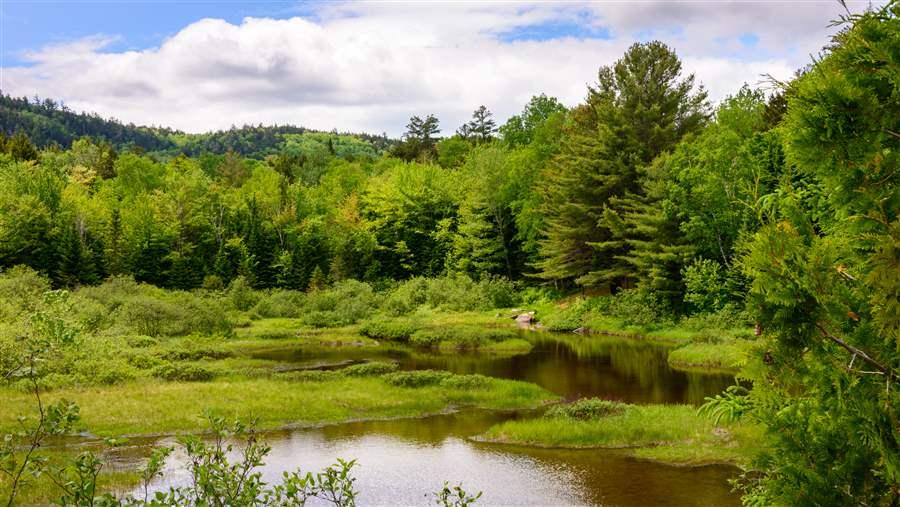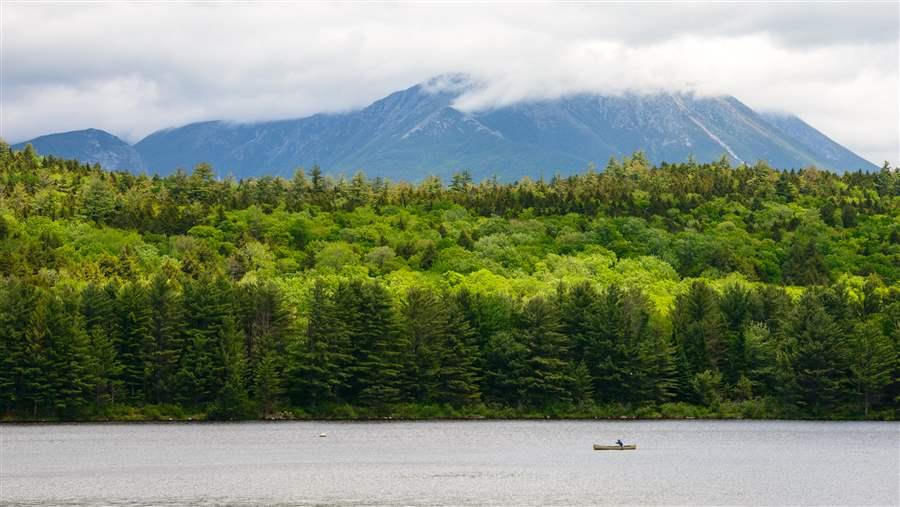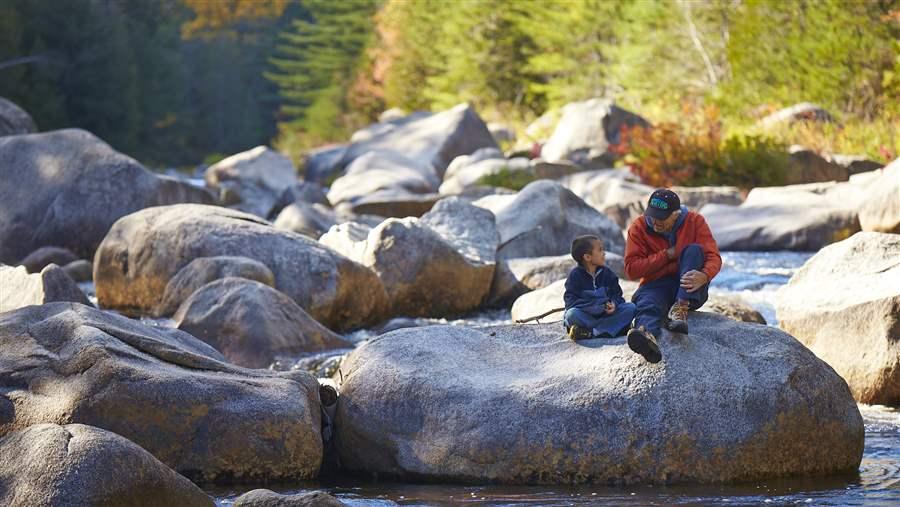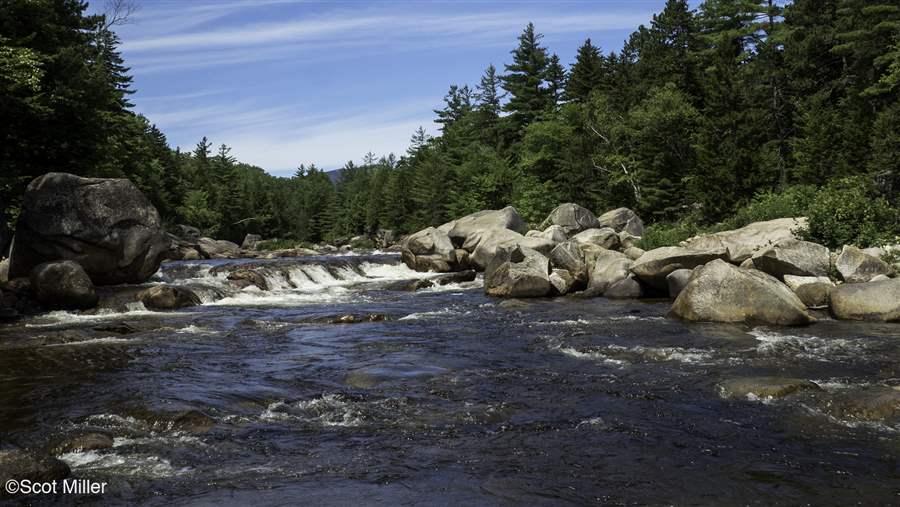Maine’s New National Monument Already Paying Dividends for Local Communities
Evidence shows value of Katahdin as President Trump starts review of public lands and waters
Update: The period for public input on the Trump administration’s national monument review closed July 10 with more than 2 million comments submitted. Interior Secretary Zinke has until Aug. 24 to present his recommendations on the monuments to President Trump.
When Lucas St. Clair traveled from Maine’s North Woods to Washington this month to tell Congress why it shouldn’t shrink or rescind the Katahdin Woods and Waters National Monument, he was not as alone as he appeared to be. St. Clair’s testimony that day to the Federal Lands Subcommittee of the House Natural Resources Committee had the support of thousands of citizens, hundreds of Maine businesses, and numerous local chambers of commerce.
Katahdin is among 27 national monuments that the Trump administration is now reviewing for possible revision or elimination. St. Clair runs a land conservation organization called Elliotsville Plantation, which his mother, Roxanne Quimby, established in 2002. The foundation donated to the federal government the 87,500 acres of deep forests, bogs, and streams about 90 miles north of Bangor that make up Katahdin Woods and Waters. The organization also pledged to set up a $40 million endowment to cover management of the land. Long before the August 2016 monument designation, St. Clair envisioned a sanctuary that the American people could enjoy and explore for generations to come.

The monument holds a diverse mix of tree species, including maple, oak, ash, beech, spruce, and hemlock, and also is home to bears, moose, and lynx.
© Zach Frank/Shutterstock
The effort to preserve the Katahdin area began in 2011, when St. Clair took the helm of the foundation. In response to community requests, he opened sections of the land to hunting and snowmobiling. Later, he and other advocates pushed to have it added to the National Park System, backed by local and regional businesses. By 2015, St. Clair was building support to conserve the land as a national monument, which could be done by presidential order. Many national parks started out as monuments, including Arches in Utah, California’s Death Valley, and another Maine gem: Acadia.
Public backing for the monument was clear, with the majority of attendees at a public forum in Orono, Maine, and a field hearing in East Millinocket signaling their support for the proposal.
Speaking at the forum, Roger Milliken Jr., head of Baskahegan, a local forest products company, said: “We need to do everything we can to make the Maine woods an engine of prosperity again, and that is why I strongly support the Maine Woods national monument.” Steve Brooke, secretary of the Maine Council of Trout Unlimited, noted that protecting the forest would help safeguard valuable fishing areas on the Penobscot, Seboeis, and Piscataquis rivers.
Although the monument is only nine months old, residents are reporting an uptick in interest and visits to the area. As St. Clair testified to Congress: “Real estate sales [in nearby communities] have picked up, multiseason visitation is increasing, and business investments are happening.” He also noted that the Butler Conservation Fund is investing $5 million to build an outdoor education facility just south of the monument.

Canoeing, fishing, hiking, and wildlife-watching are among the activities that visitors can pursue in the monument during summer. Snowmobiling is allowed in winter.
© Zach Frank/Shutterstock
Matt Polstein—owner of the New England Outdoor Center in Millinocket, who attended the congressional hearing—wrote in an opinion piece in the Bangor Daily News that “the designation of the Katahdin Woods and Waters National Monument flipped a switch in the collective consciousness of the region as to what was possible. New customers, energy, and investment are following and create a renewed sense of hope that the Katahdin region has a future and not just a past."
Others expressing support for preserving the monument as originally designated include Maine Senator Angus King (I) and Representative Chellie Pingree (D). In a letter to a constituent, Senator Susan Collins (R) wrote: “I intend to support efforts to make the Monument a success and to help the Katahdin region thrive and chart a better economic future. I believe that any effort to rescind the designation at this point would be a mistake.”
On May 5, the Interior Department released a list of the monuments set for review. A formal public comment period for these reviews is open until July 10. To share your opinion, visit https://advocacy.pewtrusts.org/page/9685/petition/1?ea.tracking.id=Web . Interior Secretary Ryan Zinke is expected to make his recommendations for most of these by the end of August.
The Pew Charitable Trusts encourages an open and transparent review process with broad citizen input, in which the administration listens “to the views of sportsmen, scientists, business leaders, Native Americans, conservationists, recreational users, and members of the faith community who are closely tied to these protected areas.”
We believe such a review of the Katahdin Woods and Waters National Monument will show that it came about because of strong support from a diverse community hoping to preserve and revive this spectacular area.
Mike Matz directs The Pew Charitable Trusts’ U.S. public lands program, focusing on wilderness and national monument projects.









